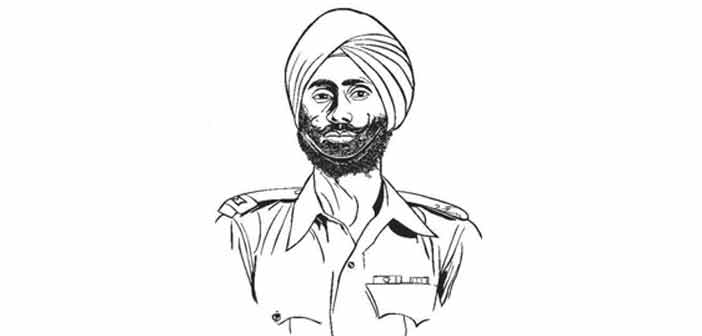Selfless devotion and valour (1914-1947)
Nand Singh was born on 24 September 1914, in village Bahadurpur in Bhatinda district of Punjab. He enlisted in 1/11 Sikh on 24 March 1933. During the Second World War, his unit was deployed along the Road Maungdaw-Bothidaung in Arakan in Burma in 1944. Japanese attempts to recapture the hill features occupied by the unit were beaten back. A feature, later called India Hill, was left unoccupied as Subedar Mehar Singh’s platoon had been pulled out to protect a disabled tank.
During the night of 1 March, a Japanese platoon infiltrated into the area and occupied India Hill. Twenty-five Dragoons were to pass through the area and it was essential to clear this feature before arrival of their transport. C Company, detailed for this task, met Subedar Mehar Singh’s platoon. They had been relieved from their task by the Gorkhas and they too joined C Company in the assault. Support of one tank was made available. The Japanese were holding deep trenches and foxholes which were well concealed and difficult to locate in the jungle. The tank brought fire upon the entire area as Naib Nand Singh, commanding the leading section, moved up for the assault. He led his men up a steep knife edge ridge under heavy machine-gun and rifle fire. In spite of being wounded in the thigh, he rushed and captured one trench with his bayonet. A grenade burst in front of him injuring him on the face and shoulders. He crawled forward and captured the second trench. All the men in his section had been killed. Yet, he dragged himself and captured the third trench as well as killing the enemy occupants with his bayonet. Fire on the remainder platoon ceased after capture of the third trench. They cleared the feature. Thirty six out of the forty enemy soldiers occupying the position were killed. Nand Singh’s dash, courage and determination resulted in the re- capture of the hill. He was awarded the Victoria Cross (VC).
He was promoted to the rank of Naib Subedar and the battalion was air transported to Srinagar on 27 October 1947. The enemy was routed in the Battle of Shalateng on 7 November and by 13 November, Uri was cleared. The liberation of Kashmir Valley was complete. About 4000 to 6000 enemy troops were estimated to be operating in the Uri sector. A determined attack by the enemy on a post of 1 Sikh on 22 November was beaten back. 1 Sikh was then withdrawn from the perimeter into reserve.
A concentration of hostile forces in the hills overlooking Uri sniped at the Uri garrison and posed a threat to the main road to Srinagar. 1 Sikh was ordered to dislodge them on 12 December. They were in high spirits and the hills resounded with their war cries. They reached the hill top and came under heavy fire from the well dug in enemy as they were returning from a different route. B Company was badly trapped and lost ten men. Fifteen wounded soldiers lay within 10 metres of the enemy trenches. A counterattack caused more casualties. D Company was ordered to attack from a flank. Nand Singh led his platoon not caring for his leg injuries. He was the first to draw blood with his bayonet and killed five enemy soldiers. The men were inspired and with the war cry of Sat Sri Akal, bayoneted the hostile force all around. The enemy broke and fled. As he stood on top of a bunker, an LMG burst stuck Nand Singh in the chest, killing him on the spot. He was awarded the Maha Vir Chakra (MVC) posthumously.
The Pakistanis recognised him because of his VC ribbon and took his body to Muzzafarabad, where it was tied to a truck and paraded through the city, saying this would be the fate of every VC holder of India. His body was then thrown into a garbage dump and never recovered. A bus stand in Bhatinda, a stadium in Meerut and a road in Uri have been named after him. A statue has been erected in Fauji Chowk, Bhatinda. A few years ago, the Punjab government granted a Class I job to his grandson by amending age old rules to honour a gallant soldier.

